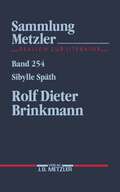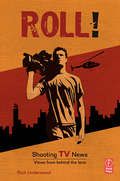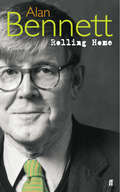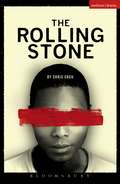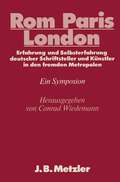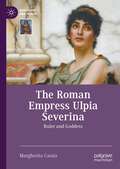- Table View
- List View
The Role of Unexpected Events in Stories: J. Bruner’s and C. Feldman’s Florentine Seminar (SpringerBriefs in Psychology)
by Andrea SmortiThis book stems primarily from the intention to make public the seminar entitled "Narratives and Cultural Psychology" held by J. Bruner and C. Feldman in May 2000 in Florence. This seminar represents the point of view of these two authors, at an important moment in their scientific and human careers, on two themes: narratives and interpretative communities.The central concept on which this book works is the Aristotelian concept of peripeteia which, born in the world of art, is developed by Bruner in the field of cognitive and cultural psychology and by Feldman in the concept of interpretative community.Thus the first purpose of this book is to analyze the role and usefulness of this concept in the study of the world of stories and cultureThe second aim of this book is to explain, clarify and comment on the concept, the theoretical assumptions and the key words used by the two authors, while also exploring the issues addressed. In this way, the author wanted to reflect on what contribution this seminar offers today to the theme of narratives and cultural psychology and what the future prospects might be.This book is aimed at students and scholars interested in exploring the role that stories play in human culture.
Role-Play and the World as Stage in the Comedia
by Jonathan ThackerThe theatrum mundi metaphor was well-known in the Golden Age, and was often employed, notably by Calderón in his religious theatre. However, little account has been given of the everyday exploitation of the idea of the world as stage in the mainstream drama of the Golden Age. This study examines how and why playwrights of the period time and again created characters who dramatise themselves, who re-invent themselves by performing new roles and inventing new plots within the larger frame of the play. The prevalence of metatheatrical techniques among Golden Age dramatists, including Lope de Vega, Tirso de Molina, Calderón de la Barca and Guillén de Castro, reveals a fascination with role-playing and its implications. Thacker argues that in comedy, these playwrights saw role-playing as a means by which they could comment on and criticise the society in which they lived, and he reveals a drama far less supportive of the social status quo in Golden Age Spain than has been traditionally thought to be the case.
Roll! Shooting TV News: Views from Behind the Lens
by Rich UnderwoodRoll! Shells fly overhead as night-scopes capture deadly fire fights with an eerie green hue, a category 5 hurricane devastates the Big Easy, hidden cameras enter a Cambodian village of brothels and a veteran journalist interviews himself throughout his own brain surgery. Part non-fiction drama, part trade publication, part text book, all woven together giving the reader a look through the viewfinders of the very best television photojournalists. As 19 experts weigh in with their candid, personal stories and photographic tips, it's as if you're over their shoulders, following their intuitions and hearing their thoughts as they shoot. The trade term for what they do is called ENG (Electronic News Gathering) and whether they're called Cameramen, Backpack Journalists, Television Photographers or any other moniker de jour, they're all paid to bring the world's events into living rooms around the world. These are the men and women who capture the bleeding edge of history - as it happens.Written in a smooth, unique interview style, this book is a necessary read for photojournalists, videographers and tv photojournalists.
Roll! Shooting TV News: Views from Behind the Lens
by Rich UnderwoodRoll! Shells fly overhead as night-scopes capture deadly fire fights with an eerie green hue, a category 5 hurricane devastates the Big Easy, hidden cameras enter a Cambodian village of brothels and a veteran journalist interviews himself throughout his own brain surgery. Part non-fiction drama, part trade publication, part text book, all woven together giving the reader a look through the viewfinders of the very best television photojournalists. As 19 experts weigh in with their candid, personal stories and photographic tips, it's as if you're over their shoulders, following their intuitions and hearing their thoughts as they shoot. The trade term for what they do is called ENG (Electronic News Gathering) and whether they're called Cameramen, Backpack Journalists, Television Photographers or any other moniker de jour, they're all paid to bring the world's events into living rooms around the world. These are the men and women who capture the bleeding edge of history - as it happens.Written in a smooth, unique interview style, this book is a necessary read for photojournalists, videographers and tv photojournalists.
Rollercoasters: 19th, 20th and 21st-Century Non-Fiction
by Christopher EdgeProviding engaging and diverse 19th21st century non-fiction and literary non-fiction texts, clustered around a range of themes, this Rollercoaster collection is ideal for use with all KS3 and KS4 students to help prepare them for the GCSE English Language and Literature requirements.
Rolling Home: One Fine Day, All Day on the Sands, Our Winnie, Rolling Home
by Alan BennettFunny, touching and real, this second collection of Alan Bennett's classic work for television from the late 1970s and early 1980s is full of fine observations of life as it is lived. Often imitated but never equalled, Bennett's work is a masterclass in how to write for the small screen and gives as much enjoyment in the reading as it did in the viewing.The television plays included in this volume are Our Winnie, All Day on the Sands, One Fine Day, Marks, Say Something Happened, Rolling Home and Intensive Care. This volume also contains a new general introduction by Alan Bennett.A companion volume of Alan Bennett's work from the 1970s is published as Me, I'm Afraid of Virginia Woolf.
The Rolling Stone (Modern Plays)
by Chris UrchOne day you're you. The next you're – I can't even say the word. Dembe and Sam have been seeing each other for a while. They should be wondering where this is going and when to introduce each other to their families. But they're gay and this is Uganda. The consequences of their relationship being discovered will be violent and explosive. Especially for Dembe, whose brother goes into the pulpit each week to denounce the evils of one man loving another.A Bruntwood Prize for Playwriting winner in 2013, The Rolling Stone received its world premiere at the Royal Exchange, Manchester, on 21 April 2015.
The Rolling Stone (Modern Plays)
by Chris UrchOne day you're you. The next you're – I can't even say the word. Dembe and Sam have been seeing each other for a while. They should be wondering where this is going and when to introduce each other to their families. But they're gay and this is Uganda. The consequences of their relationship being discovered will be violent and explosive. Especially for Dembe, whose brother goes into the pulpit each week to denounce the evils of one man loving another.A Bruntwood Prize for Playwriting winner in 2013, The Rolling Stone received its world premiere at the Royal Exchange, Manchester, on 21 April 2015.
Rom - Paris - London: Erfahrung und Selbsterfahrung deutscher Schriftsteller und Künstler in den fremden Metropolen. DFG-Symposion 1985 (Germanistische Symposien)
Die hier versammelten Beiträge zielen auf einen grundsätzliche Klärung der Mentalitäts- und Identitätsgeschichte der deutschen literarischen Intelligenz ab und sind damit nicht nur von literaturgeschichtlichem, sondern auch von sozialwissenschaftlichen Interesse. Sie reichen zeitlich von Martin Luther bis Rolf Dieter Brinkmann, mit Schwerpunkt bei Dichtern und Schriftstellern des späten 18. und frühen 19. Jahrhunderts.
Roma Voices in the German-Speaking World (New Directions in German Studies)
by Lorely FrenchThe Roma are Europe's largest minority, and yet they remain one of the most misunderstood and underrepresented. Scholarship on the Roma in German-speaking countries has focused mostly on the portrayal of “Zigeuner/Gypsies” in literature by non-Roma and on persecution during the Nazi period. Rarely have scholars examined the actual voices of Roma to glean their perspectives on their social interactions and customs. Without such studies the Roma appear passive in the face of their long and troubled history. With a basis in theories of intersectionality, subalternity, and cultural hybridity, Roma Voices in the German-Speaking World rectifies this image of passivity by analyzing autobiographies, folktales, and novels by Roma, thereby promoting a better understanding of the multifaceted and multifarious cultures alive today in Germany, Austria, and Switzerland. In documenting their voices, Roma writers unveil the large extent to which their personal lives, their social interactions with other Roma and non-Roma, and the images they project of their values and traditions are highly influenced by gender and ethnicity. Anthropological and historical studies have frequently portrayed Romani groups as displaying a patriarchal social structure with highly demarcated roles for men and women. In contrast, the significant parts that both men and women play in disseminating autobiographical, fictional, and historical narratives challenge this ubiquitous notion of largely patriarchal Romani cultures. The insights that both sexes provide on the relationship between gender and ethnicity in the context of cultural taboos, norms, and expectations unveil the complexities and diversities inherent in any minority group and its relationship to the dominant society.
Roma Voices in the German-Speaking World (New Directions in German Studies)
by Lorely FrenchThe Roma are Europe's largest minority, and yet they remain one of the most misunderstood and underrepresented. Scholarship on the Roma in German-speaking countries has focused mostly on the portrayal of “Zigeuner/Gypsies” in literature by non-Roma and on persecution during the Nazi period. Rarely have scholars examined the actual voices of Roma to glean their perspectives on their social interactions and customs. Without such studies the Roma appear passive in the face of their long and troubled history. With a basis in theories of intersectionality, subalternity, and cultural hybridity, Roma Voices in the German-Speaking World rectifies this image of passivity by analyzing autobiographies, folktales, and novels by Roma, thereby promoting a better understanding of the multifaceted and multifarious cultures alive today in Germany, Austria, and Switzerland. In documenting their voices, Roma writers unveil the large extent to which their personal lives, their social interactions with other Roma and non-Roma, and the images they project of their values and traditions are highly influenced by gender and ethnicity. Anthropological and historical studies have frequently portrayed Romani groups as displaying a patriarchal social structure with highly demarcated roles for men and women. In contrast, the significant parts that both men and women play in disseminating autobiographical, fictional, and historical narratives challenge this ubiquitous notion of largely patriarchal Romani cultures. The insights that both sexes provide on the relationship between gender and ethnicity in the context of cultural taboos, norms, and expectations unveil the complexities and diversities inherent in any minority group and its relationship to the dominant society.
The Roman Book (Classical Literature and Society)
by Rex WinsburyThe publishing of Roman books has long and often been misrepresented by false analogies with modern publishing. This comprehensive new study examines, by appeal to what Roman authors themselves tell us, both the raw materials and aesthetic criteria of the Roman book (a papyrus scroll) and the process of literary composition. What was the 'scribal art' of the time? What was the role of bookshops and libraries? What control did an author have over his creation? How were new books received and used by readers? To answer these questions Roman publishing is placed firmly in the context of a society that, despite the omnipresence of writing, was still predominantly oral. This context helps to explain how some books and authors became politically dangerous, and how the Roman book could be both a cultural icon and integral part of the self-definition of Rome's governing elite and a direct contributor to popular culture through the mass medium of the Roman theatre.
The Roman Book (Classical Literature and Society)
by Rex WinsburyThe publishing of Roman books has long and often been misrepresented by false analogies with modern publishing. This comprehensive new study examines, by appeal to what Roman authors themselves tell us, both the raw materials and aesthetic criteria of the Roman book (a papyrus scroll) and the process of literary composition. What was the 'scribal art' of the time? What was the role of bookshops and libraries? What control did an author have over his creation? How were new books received and used by readers? To answer these questions Roman publishing is placed firmly in the context of a society that, despite the omnipresence of writing, was still predominantly oral. This context helps to explain how some books and authors became politically dangerous, and how the Roman book could be both a cultural icon and integral part of the self-definition of Rome's governing elite and a direct contributor to popular culture through the mass medium of the Roman theatre.
Roman Catholic Saints and Early Victorian Literature: Conservatism, Liberalism, and the Emergence of Secular Culture
by Devon FisherOffering readings of nineteenth-century travel narratives, works by Tractarians, the early writings of Charles Kingsley, and the poetry of Alfred Tennyson, Devon Fisher examines representations of Roman Catholic saints in Victorian literature to assess both the relationship between conservative thought and liberalism and the emergence of secular culture during the period. The run-up to Victoria's coronation witnessed a series of controversial liberal reforms. While many early Victorians considered the repeal of the Test and Corporation Acts (1828), the granting of civil rights to Roman Catholics (1829), and the extension of the franchise (1832) significant advances, for others these three acts signaled a shift in English culture by which authority in matters spiritual and political was increasingly ceded to individuals. Victorians from a variety of religious perspectives appropriated the lives of Roman Catholic saints to create narratives of English identity that resisted the recent cultural shift towards private judgment. Paradoxically, conservative Victorians' handling of the saints and the saints' lives in their sheer variety represented an assertion of individual authority that ultimately led to a synthesis of liberalism and conservatism and was a key feature of an emergent secular state characterized not by disbelief but by a range of possible beliefs.
Roman Catholic Saints and Early Victorian Literature: Conservatism, Liberalism, and the Emergence of Secular Culture
by Devon FisherOffering readings of nineteenth-century travel narratives, works by Tractarians, the early writings of Charles Kingsley, and the poetry of Alfred Tennyson, Devon Fisher examines representations of Roman Catholic saints in Victorian literature to assess both the relationship between conservative thought and liberalism and the emergence of secular culture during the period. The run-up to Victoria's coronation witnessed a series of controversial liberal reforms. While many early Victorians considered the repeal of the Test and Corporation Acts (1828), the granting of civil rights to Roman Catholics (1829), and the extension of the franchise (1832) significant advances, for others these three acts signaled a shift in English culture by which authority in matters spiritual and political was increasingly ceded to individuals. Victorians from a variety of religious perspectives appropriated the lives of Roman Catholic saints to create narratives of English identity that resisted the recent cultural shift towards private judgment. Paradoxically, conservative Victorians' handling of the saints and the saints' lives in their sheer variety represented an assertion of individual authority that ultimately led to a synthesis of liberalism and conservatism and was a key feature of an emergent secular state characterized not by disbelief but by a range of possible beliefs.
Roman de Brut (Oxford World's Classics)
by Wace'Whoever wishes to hear about, and to know about, kings and heirs, about who first ruled England and which kings it had, Master Wace, who is telling the truth about this, has translated this.' Wace's Roman de Brut (1155) can be seen as the gateway to the history of the Britons for both French and English speakers of the time, and thus to Arthurian history, as the first complete Old French adaptation of Geoffrey of Monmouth's Latin History of the Kings of Britain (late 1130s), in which Arthur appears for the first time as king of the Britons. The Roman de Brut was a foundational work, an inspiration for a series of anonymous verse Bruts of the late twelfth and thirteenth centuries and for the Anglo-Norman Prose Brut — the most widely read French vernacular text on this material in medieval England — as well as a forerunner of the Middle English Brut tradition, including Layamon's Brut (c. 1200). Wace's poem thus inaugurates and shapes Brut traditions, including Arthurian tales, in verse and in prose, in historiography and in literature, including Wace's innovation of King Arthur's Round Table. This volume contains an English prose translation of Wace's Roman de Brut, accompanied by an introduction and notes, a select bibliography, a summary of the text, a list of manuscripts, and indexes of personal and geographical names.
Roman de Brut (Oxford World's Classics)
by Wace'Whoever wishes to hear about, and to know about, kings and heirs, about who first ruled England and which kings it had, Master Wace, who is telling the truth about this, has translated this.' Wace's Roman de Brut (1155) can be seen as the gateway to the history of the Britons for both French and English speakers of the time, and thus to Arthurian history, as the first complete Old French adaptation of Geoffrey of Monmouth's Latin History of the Kings of Britain (late 1130s), in which Arthur appears for the first time as king of the Britons. The Roman de Brut was a foundational work, an inspiration for a series of anonymous verse Bruts of the late twelfth and thirteenth centuries and for the Anglo-Norman Prose Brut — the most widely read French vernacular text on this material in medieval England — as well as a forerunner of the Middle English Brut tradition, including Layamon's Brut (c. 1200). Wace's poem thus inaugurates and shapes Brut traditions, including Arthurian tales, in verse and in prose, in historiography and in literature, including Wace's innovation of King Arthur's Round Table. This volume contains an English prose translation of Wace's Roman de Brut, accompanied by an introduction and notes, a select bibliography, a summary of the text, a list of manuscripts, and indexes of personal and geographical names.
The Roman de la rose in its Philosophical Context: Art, Nature, and Ethics (Oxford Modern Languages and Literature Monographs)
by Jonathan MortonThe Roman de la rose in its Philosophical Context offers a new interpretation of the long and complex medieval allegorical poem written by Guillaume de Lorris and Jean de Meun in the thirteenth century, a work that became one of the most influential works of vernacular literature in the European Middle Ages. The scope and sophistication of the poem's content, especially in Jean's continuation, has long been acknowledged, but this is the first book-length study to offer an in-depth analysis of how the Rose draws on, and engages with, medieval philosophy, in particular with the Aristotelianism that dominated universities in the thirteenth century. It considers the limitations and possibilities of approaching ideas through the medium of poetic fiction, whose lies paradoxically promise truth and whose ambiguities and self-contradiction make it hard to discern its positions. This indeterminacy allows poetry to investigate the world and the self in ways not available to texts produced in the Scholastic context of universities, especially those of the University of Paris, whose philosophical controversies in the 1270s form the backdrop against which the poem is analysed. At the heart of the Rose are the three ideas of art, nature, and ethics, which cluster around its central subject: love. While the book offers larger claims about the Rose's philosophical agenda, different chapters consider the specifics of how it draws on, and responds to, Roman poetry, twelfth-century Neoplatonism, and thirteenth-century Aristotelianism in broaching questions about desire, epistemology, human nature, the imagination, primitivism, the philosophy of art, and the ethics of money.
The Roman de la rose in its Philosophical Context: Art, Nature, and Ethics (Oxford Modern Languages and Literature Monographs)
by Jonathan MortonThe Roman de la rose in its Philosophical Context offers a new interpretation of the long and complex medieval allegorical poem written by Guillaume de Lorris and Jean de Meun in the thirteenth century, a work that became one of the most influential works of vernacular literature in the European Middle Ages. The scope and sophistication of the poem's content, especially in Jean's continuation, has long been acknowledged, but this is the first book-length study to offer an in-depth analysis of how the Rose draws on, and engages with, medieval philosophy, in particular with the Aristotelianism that dominated universities in the thirteenth century. It considers the limitations and possibilities of approaching ideas through the medium of poetic fiction, whose lies paradoxically promise truth and whose ambiguities and self-contradiction make it hard to discern its positions. This indeterminacy allows poetry to investigate the world and the self in ways not available to texts produced in the Scholastic context of universities, especially those of the University of Paris, whose philosophical controversies in the 1270s form the backdrop against which the poem is analysed. At the heart of the Rose are the three ideas of art, nature, and ethics, which cluster around its central subject: love. While the book offers larger claims about the Rose's philosophical agenda, different chapters consider the specifics of how it draws on, and responds to, Roman poetry, twelfth-century Neoplatonism, and thirteenth-century Aristotelianism in broaching questions about desire, epistemology, human nature, the imagination, primitivism, the philosophy of art, and the ethics of money.
Roman Domestic Medical Practice in Central Italy: From the Middle Republic to the Early Empire (Medicine and the Body in Antiquity)
by Jane DraycottRoman Domestic Medical Practice in Central Italy examines the roles that the home, the garden and the members of the household (freeborn, freed and slave) played in the acquisition and maintenance of good physical and mental health and well-being. Focussing on the period from the middle Republic to the early Empire, it considers how comprehensive the ancient Roman general understanding of health actually was, and studies how knowledge regarding various aspects of health was transmitted within the household. Using literary, documentary, archaeological and bioarchaeological evidence from a variety of contexts, this is the first extended volume to provide as comprehensive and detailed a reconstruction of this aspect of ancient Roman private life as possible, complementing existing works on ancient professional medical practice and existing works on domestic medical practice in later historical periods. This volume offers an indispensable resource to social historians, particularly those that focus on the ancient family, and medical historians, particularly those that focus on the ancient world.
Roman Domestic Medical Practice in Central Italy: From the Middle Republic to the Early Empire (Medicine and the Body in Antiquity)
by Jane DraycottRoman Domestic Medical Practice in Central Italy examines the roles that the home, the garden and the members of the household (freeborn, freed and slave) played in the acquisition and maintenance of good physical and mental health and well-being. Focussing on the period from the middle Republic to the early Empire, it considers how comprehensive the ancient Roman general understanding of health actually was, and studies how knowledge regarding various aspects of health was transmitted within the household. Using literary, documentary, archaeological and bioarchaeological evidence from a variety of contexts, this is the first extended volume to provide as comprehensive and detailed a reconstruction of this aspect of ancient Roman private life as possible, complementing existing works on ancient professional medical practice and existing works on domestic medical practice in later historical periods. This volume offers an indispensable resource to social historians, particularly those that focus on the ancient family, and medical historians, particularly those that focus on the ancient world.
The Roman Empress Ulpia Severina: Ruler and Goddess (Queenship and Power)
by Margherita CassiaOf the twelve Augustae who lived during the fifty years of the so-called “military anarchy” (235-284 A.D.), Ulpia Severina, wife of the “Illyrian” emperor Aurelian (270-275 AD), is certainly one of the most enigmatic and less known. The book focuses on Ulpia Severina, who, even though never mentioned by name in literary sources, has been studied almost exclusively from the perspective of the numerous coins issued in her name and is the subject of many interesting honorific inscriptions that had not been thoroughly examined or adequately valued until this study. This exceptional situation, represented by the sole presence of Ulpia Severina on the throne of Rome, deserves more attention than it has received. The pages of the university history textbooks dedicated to the reconstruction of a fifty-year phase of Roman-imperial history must be, if not rewritten, at least integrated in order to give the deserved space to this empress and, therefore, to the so-called “interregnum,” which lasted at least two months, between the death of Aurelian and the advent of emperor Tacitus.
The Roman Garden: Space, Sense, and Society (Routledge Monographs in Classical Studies)
by Katharine T. von StackelbergThis innovative book is the first comprehensive study of ancient Roman gardens to combine literary and archaeological evidence with contemporary space theory. It applies a variety of interdisciplinary methods including access analysis, literary and gender theory to offer a critical framework for interpreting Roman gardens as physical sites and representations. The Roman Garden: Space, Sense, and Society examines how the garden functioned as a conceptual, sensual and physical space in Roman society, and its use as a vehicle of cultural communication. Readers will learn not only about the content and development of the Roman garden, but also how they promoted memories and experiences. It includes a detailed original analysis of garden terminology and concludes with three case studies on the House of Octavius Quartio and the House of the Menander in Pompeii, Pliny’s Tuscan garden, and Caligula’s Horti Lamiani in Rome. Providing both an introduction and an advanced analysis, this is a valuable and original addition to the growing scholarship in ancient gardens and will complement courses on Roman history, landscape archaeology and environmental history.
The Roman Garden: Space, Sense, and Society (Routledge Monographs in Classical Studies)
by Katharine T. von StackelbergThis innovative book is the first comprehensive study of ancient Roman gardens to combine literary and archaeological evidence with contemporary space theory. It applies a variety of interdisciplinary methods including access analysis, literary and gender theory to offer a critical framework for interpreting Roman gardens as physical sites and representations. The Roman Garden: Space, Sense, and Society examines how the garden functioned as a conceptual, sensual and physical space in Roman society, and its use as a vehicle of cultural communication. Readers will learn not only about the content and development of the Roman garden, but also how they promoted memories and experiences. It includes a detailed original analysis of garden terminology and concludes with three case studies on the House of Octavius Quartio and the House of the Menander in Pompeii, Pliny’s Tuscan garden, and Caligula’s Horti Lamiani in Rome. Providing both an introduction and an advanced analysis, this is a valuable and original addition to the growing scholarship in ancient gardens and will complement courses on Roman history, landscape archaeology and environmental history.


